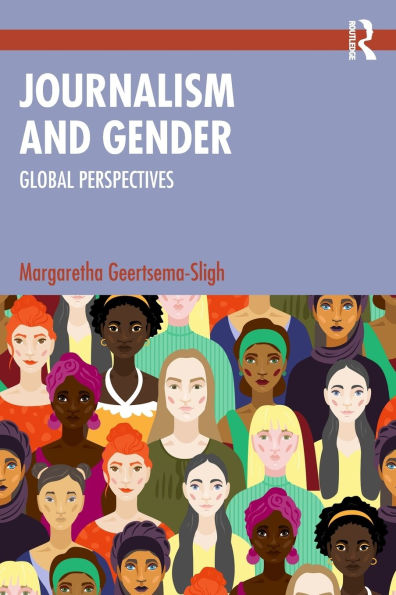Table of Contents
Preface
Acknowledgments
Part 1 Theoretical Perspectives Chapter 1: Global Perspectives on Journalism and Gender
Overview
Student Learning Outcomes
The Purpose of Journalism and Gender: Global Perspectives
The Dominance of Western Scholarship
English as the Global Language
De-Westernization, Decolonization, and Southernization of Journalism Studies
Lack of Scholarship on Journalism and Gender Outside the Global North
Defining This Book’s Key Terms
Outline of Book Chapters
Conclusion
Summary
Glossary Terms and Concepts
Discussion Questions
References
Chapter 2: Journalism and Diversity in Theory and Practice
Overview
Student Learning Outcomes
The Need for Diversity in Journalism Theory
Journalism’s Historical Connection to Democracies
The Legacy of Four Theories of the Press
Beyond North America and Western Europe
Insights from the Worlds of Journalism Study
Box: Journalism in a Nondemocratic Regime: The Case of Belarus
The Need for Diversity in Journalism Practice
The Case for Diversity
Box: Section J of the Beijing Declaration and Platform for Action
Demographic Diversity of Journalists
Newsroom Demographics
Diversity in News Topics and Representations
Box: Coalition for Women in Journalism
Summary
Conclusion
Glossary Terms and Concepts
Discussion Questions
References
Chapter 3: Understanding Feminisms and Intersectionality
Overview
Student Learning Outcomes
What Is Feminism?
The Dominance of Western Feminism
Global Feminism
Women’s Rights as Human Rights
Transnational Feminism
Feminisms from the Global South
Box: The International Women’s Development Agency
Intersectionality
Feminist Communication and Media Theory
Application to Journalism and Gender
A Human Rights Approach
An Intersectional Approach
Feminist Perspectives from the Global South
Conclusion
Summary
Glossary Terms and Concepts
Discussion Questions
References
Chapter 4: A Media Sociology Framework
Overview
Student Learning Outcomes
The Social Construction of Reality
A Media Sociology Framework
Box: Gaye Tuchman and the Symbolic Annihilation of Women
The Hierarchy of Influences Model
Social Systems Level
Social Institutions Level
Organizational Level
Media Routines Level
Individual Level
Conclusion
Summary
Glossary Terms and Concepts
Discussion Questions
References
Part 2 A Global Approach Chapter 5: Toward a Global History of Women in Journalism
Overview
Student Learning Outcomes
Challenges of Studying the Global History of Women in Journalism
Box: The Public Sphere and the Private Sphere
Journalism as an Unacceptable Career for Women
Intersectionality and Early Women Journalists
Separate Publications for Women
Women’s Pages, Sections, and Columns
Supporting Marginalized Groups
Reasons for Women’s Entry to Journalism
Conclusion
Summary
Glossary Terms and Concepts
Discussion Questions
References
Chapter 6: Global Reports on Women and Journalism
Overview
Student Learning Outcomes
The Earliest Global Reports
Mass Media: The Image, Role, and Societal Conditions of Women (1979)
Unequal Opportunities: The Case of Women and the Media (1981)
An Unfinished Story: Gender Patterns in Media Employment (1995)
Contemporary Global Reports
The Global Media Monitoring Project (1995–2020)
The IWMF’s Global Report on the Status of Women in the News Media (2011)
Box: The International Women’s Media Foundation
Women and Leadership in the News Media Series (2024)
The Missing Perspectives Report Series (2020–2022)
Conclusion
Summary
Glossary Terms and Concepts
Discussion Questions
References
Chapter 7: Worldwide Violence Against Women Reporters
Overview
Student Learning Outcomes
The Gendered Nature of Violence Against Women Reporters
Online Attacks Against Women Reporters
Box: Threats Against Women Reporters in South Africa
Sexual Harassment of Women Journalists
The Impact of Violence and Harassment on Women Reporters
Strategies for Dealing with Violence and Harassment
Conclusion
Summary
Glossary Terms and Concepts
Discussion Questions
References
Part 3 Women’s Participation in News Production Chapter 8: Gender and Newswork
Overview
Student Learning Outcomes
Newswork Is for Men
Men-Dominated Newsroom Cultures
Horizontal Job Segregation and Beat Assignments
Marriage, Motherhood, and Family Responsibilities
Women’s Responses to Men-Dominated Newsroom Cultures
The Impact of Intersectionality
Box: African Women in Media
Conclusion
Summary
Glossary Terms and Concepts
Discussion Questions
References
Chapter 9: Women Making News
Overview
Student Learning Outcomes
Women in Television Journalism
Women in Men-Dominated News Areas
War Reporting
Box: Christiane Amanpour
Reporting Politics
Sports Reporting
Photojournalism
Women in Newsroom Leadership
The Glass Ceiling
Reasons for Women’s Underrepresentation in Leadership Positions
Increasing the Number of Women in Leadership
Leadership and Intersectionality
Conclusion
Summary
Glossary Terms and Concepts
Discussion Questions
References
Part 4 News Representations of Women Chapter 10: News Representations of Violence Against Women and Women in Politics
Overview
Student Learning Outcomes
News Representations of VAW
Femicide in the News
Rape in the News
Box: Progressive Coverage of Violence Against Women
News Representations of Women in Politics
Women in Formal Politics
Women in Informal Politics
Conclusion
Summary
Glossary Terms and Concepts
Discussion Questions
References
Chapter 11: News Representations of Women, War, and Terrorism
Overview
Student Learning Outcomes
Women and War
Box: How to Improve News Coverage of Women and War
Military Women and Fighters
Women Terrorists and Suicide Bombers
Women and ISIS
Women Refugees and Migrants
Box: The Clash of Civilizations
Conclusion
Summary
Glossary Terms and Concepts
Discussion Questions
References
Part 5 Toward Change Chapter 12: Gender and International Media Development
Overview
Student Learning Outcomes
Development and Communication
Development Communication
International Media Development
Gender and Development
Gender Mainstreaming
Box: Gender Mainstreaming in Global News
Gender Transformative Approaches
Box: Gender in Media Development: The Case of Internews
Conclusion
Summary
Glossary Terms and Concepts
Discussion Questions
References
Chapter 13: Feminist Media Activism and Journalism Education
Overview
Student Learning Outcomes
Feminist Media Activism
Box: Gender Links: Challenging the Lion in Its Den
Global Gender Media Monitoring
Global Gender and Media Policy Advocacy
Box: The Global Alliance on Media and Gender
Journalism Education
Decolonizing Journalism Education
Implementing Critical and Feminist Pedagogies
Gender in Journalism Curricula
Conclusion
Summary
Glossary Terms and Concepts
Discussion Questions
References
Final Thoughts
Looking Back
What You Have Learned
Countries Included in This Book
Looking Forward
Research Gaps
Your Future
Discussion Questions
Appendix
Table 1: List of Countries Included by Region
Table 2: List of Countries Not Included by Region
Glossary



